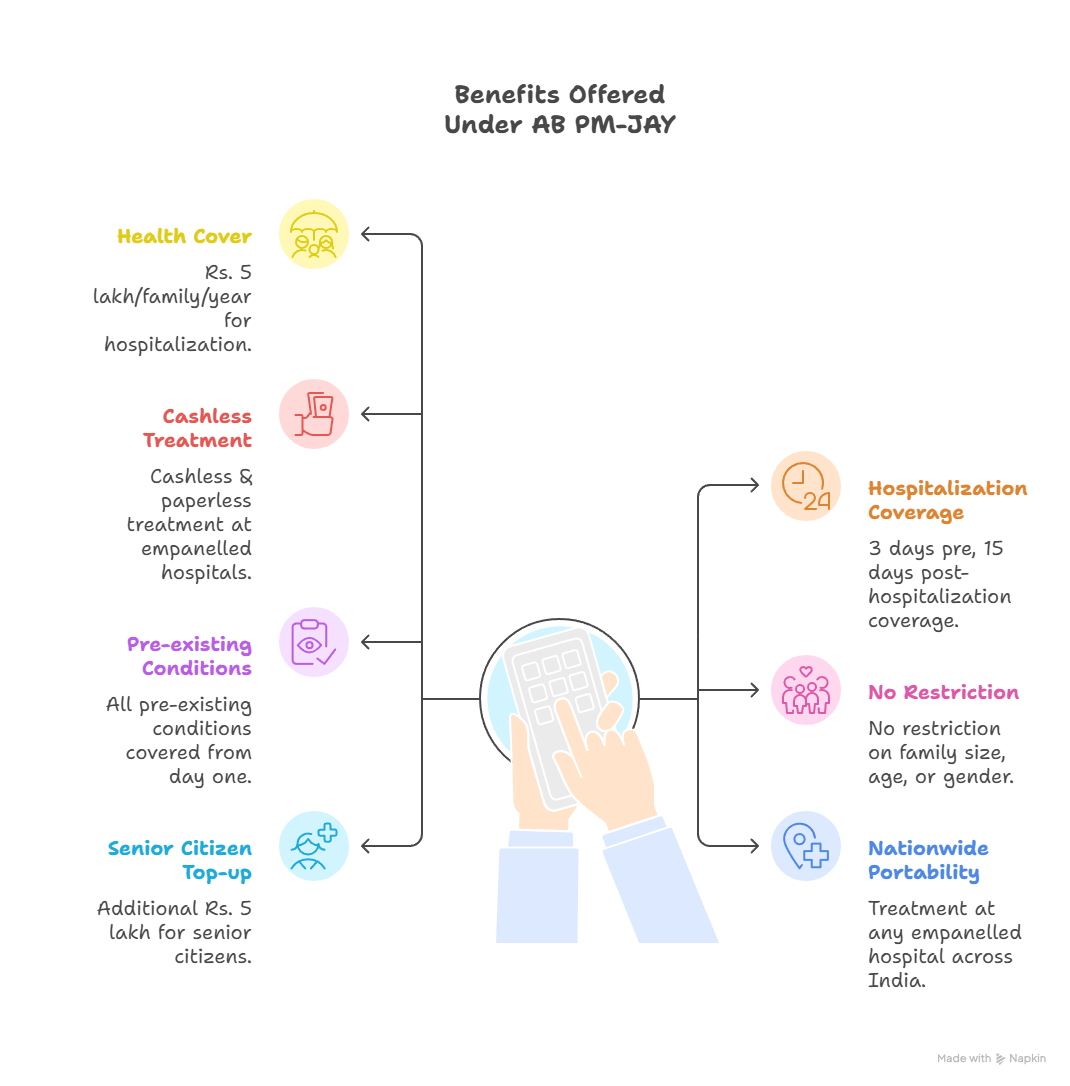Governance
Ayushman Bharat and Universal Health Coverage
- 18 Oct 2025
- 10 min read
For Prelims: National Health Authority, Ayushman Bharat–Pradhan Mantri Jan Arogya Yojana, ABHA number, National Health Protection Scheme, Ayushman Bharat Health and Wellness Centres.
For Mains: Role of Ayushman Bharat in advancing Universal Health Coverage (UHC) in India. Reasons for private hospital dominance in government-sponsored health schemes. Primary, Secondary, and Tertiary Care Strengthening.
Why in News?
The National Health Authority’s (NHA) Annual Report 2024–25 has revealed that under the Ayushman Bharat–Pradhan Mantri Jan Arogya Yojana (AB-PMJAY) while government hospitals make up the majority of empanelled institutions, most beneficiaries are actually availing treatment in private hospitals, often at higher costs.
What are the Key Findings Regarding the AB-PMJAY?
- Dominance of Private Hospitals: Of the 31,005 hospitals empanelled under AB-PMJAY, only 45% are private, yet they account for 52% of the 9.19 crore hospitalisations and receive 66% of the total ₹1.29 lakh crore treatment cost.
- Treatment Trends: Since 2018, 14% of treatments under AB-PMJAY have been for haemodialysis, followed by fever (4%), gastroenteritis (3%), and animal bites (3%). In 2024‑25, the top specialties were General Medicine, Ophthalmology, and General Surgery.
- Patient Mobility: A key feature of Ayushman Bharat is portability, enabling treatment across states.
- Top in-migration destinations are Chandigarh (19%), Uttar Pradesh (13%), and Gujarat (11%), while states with highest out-migration are Uttar Pradesh (24%), Madhya Pradesh (17%), and Bihar (16%).
- Digital Ecosystem Progress: The government’s digital health ecosystem is progressing fast: 6 in 10 people have an ABHA number, 50 crore health records are linked, 38% of health facilities and 26% of health personnel are registered on the system.
- ABHA number is a 14-digit ID that creates a cloud-based account for securely storing digital health records.
What is Ayushman Bharat-Pradhan Mantri Jan Arogya Yojana?
- About: Ayushman Bharat-PM-JAY is India’s flagship health insurance scheme providing financial protection for secondary and tertiary care to vulnerable families, aiming to reduce catastrophic hospital expenses and promote Universal Health Coverage (UHC).
- Formerly National Health Protection Scheme (NHPS), it subsumed the Rashtriya Swasthya Bima Yojana (RSBY, 2008) and is run by the Ministry of Health & Family Welfare.
- Target Beneficiaries: It covers 12 crore families (around 55 crore people), prioritizing the poorest 40% of the population. Beneficiaries are identified through the Socio-Economic Caste Census (SECC-2011) and prior RSBY coverage.
- Senior citizens aged 70+ are eligible irrespective of income, totaling around 6 crore beneficiaries.
- Funding Pattern: The scheme is fully government-funded with Centre-State sharing: 60:40 for most states, 90:10 for North-Eastern and Himalayan states, and 100% central funding for Union Territories without a legislature.
- Key Components:
- Ayushman Arogya Mandirs (AAMs): It plans plan to set up 1,50,000 centres (formerly Ayushman Bharat Health and Wellness Centres) to provide comprehensive, free primary healthcare, including non-communicable diseases, palliative and rehabilitative care, oral, eye, ENT, and mental health services.
- Pradhan Mantri Jan Arogya Yojana (PMJAY): It provides health coverage of Rs 5 lakh per family per year for secondary and tertiary care hospitalization.
- Implementing Structure:
- National Health Authority (NHA): Autonomous body, chaired by Union Health Minister.
- State Health Authority (SHA): Headed by a CEO appointed by the state government.
- District Implementing Unit (DIU): Chaired by District Collector/DC/DM.
- Benefits Offered:
- Key Achievements:
- Wide Reach: Over 35.4 crore Ayushman cards issued; operational in 33 States/UTs.
- Gender Equity: 49% of cards issued to women, with 3.61 crore hospitalizations availed.
- Financial Impact: 21% reduction in out-of-pocket expenses and 8% decline in emergency health loans.
- District Hospital Gains: Annual net benefit of USD 26.1 million, projected to reach USD 41.8 million (USD 169,607 per hospital).
What are the Key Issues Hindering Universal Health Coverage in India?
- Inadequate Public Health Financing: India’s public health expenditure is low at 1.84% of GDP, below the National Health Policy 2017 target of 2.5%, resulting in underfunded health infrastructure, while out-of-pocket expenditure (OOPE) stood at 39.4%.
- Limited & Uneven Reach: Schemes like Ayushman Bharat PM-JAY leave out the “missing middle” (not poor enough for subsidies, not rich enough for private insurance) and focus on secondary/tertiary care, neglecting primary and outpatient services, which account for a large part of out-of-pocket expenditure (OOPE).
- Rural-Urban Imbalance: Most healthcare professionals are in urban private sectors, leading to rural shortages and insufficient public health and paramedical staff to address diseases.
- Weak Primary Healthcare: A weak primary care system forces patients to overcrowd tertiary hospitals for minor ailments, with the health system focused more on treatment than wellness and prevention.
- Regulatory Gaps: The private sector, delivering the majority of care, shows inconsistent quality and poor regulation, leading to unethical practices and overcharging, while inadequate health data systems limit evidence-based policymaking.
What Measures can be Adopted to Achieve Universal Health Coverage in India?
- Increase Public Health Funding: Increase public health spending to 2.5% of GDP, directing more funds to strengthen primary care (AAMs) and establish a robust gatekeeping system.
- Integrate Health Insurance: Develop affordable insurance for the currently excluded population and expand coverage from hospitalization to outpatient care, diagnostics, and medicines.
- Strengthen the Health Workforce: Expand medical and nursing colleges in underserved areas, provide incentives to retain rural health professionals, and invest in training community health workers, nurses, and paramedics.
- Leverage Technology: Leverage telemedicine and the ABHA digital ecosystem to provide specialist care remotely, and run public health campaigns on Noncommunicable diseases (NCDs), sanitation, and nutrition.
- Improve Governance: Enforce the Clinical Establishments Act, 2010 for quality and cost standards, implement evidence-based treatment guidelines, and strengthen data systems for monitoring, planning, and accountability.
Conclusion
AB PM-JAY has significantly advanced Universal Health Coverage by providing massive financial protection and reducing out-of-pocket expenditure. However, its success highlights a critical challenge: the overwhelming patient preference for private healthcare, underscoring the need to enhance the quality and capacity of public health infrastructure for sustainable equity.
|
Drishti Mains Question: Discuss how the Ayushman Bharat–Pradhan Mantri Jan Arogya Yojana (PM-JAY) contributes to achieving Universal Health Coverage (UHC) in India. |
Frequently Asked Questions (FAQs)
1. What is AB-PMJAY?
AB-PMJAY is India’s flagship health insurance scheme providing Rs 5 lakh per family per year for secondary and tertiary care, aiming to achieve Universal Health Coverage for vulnerable populations.
2. Why do people prefer private hospitals under AB-PMJAY?
Private hospitals are preferred due to advanced technology, better infrastructure, specialist availability, attentive care, and faster access, despite only 45% of empanelled hospitals being private.
3. How does AB-PMJAY promote gender equity?
49% of Ayushman cards are issued to women, and 3.61 crore hospitalizations have supported female beneficiaries, ensuring inclusive healthcare access.
UPSC Civil Services Examination, Previous Year Question (PYQ)
Prelims
Q. With reference to the National Rural Health Mission, which of the following are the jobs of ‘ASHA’, a trained community health worker? (2012)
- Accompanying women to the health facility for antenatal care checkup
- Using pregnancy test kits for early detection of pregnancy
- Providing information on nutrition and immunization.
- Conducting the delivery of baby
Select the correct answer using the codes given below:
(a) 1, 2 and 3 only
(b) 2 and 4 only
(c) 1 and 3 only
(d) 1, 2, 3 and 4
Ans: (a)
Mains
Q. The public health system has limitations in providing universal health coverage. Do you think that the private sector could help in bridging the gap? What other viable alternatives would you suggest? (2015)








